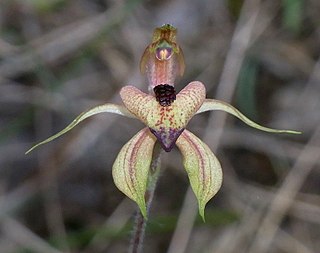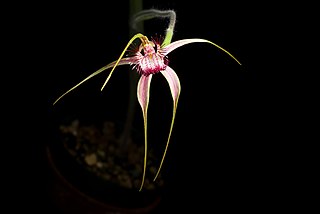
Caladenia paludosa, commonly known as the swamp spider orchid, is a species of orchid endemic to the south-west of Western Australia. It has a single erect, hairy leaf and up to three red, greenish-yellow and cream-coloured flowers. It mostly grows in dense scrub and is one of the last of the similar spider orchids to flower.

Caladenia dimidia, commonly known as the chameleon orchid is a species of orchid endemic to the south-west of Western Australia. It has a single hairy leaf and one or two yellow, cream-coloured or pinkish flowers. It is a variable species, similar to the Joseph's spider orchid but has a more northerly distribution and smaller flowers.

Caladenia cardiochila, commonly known as thick-lipped spider-orchid, fleshy-lipped caladenia and heartlip spider-orchid, is a plant in the orchid family Orchidaceae and is endemic to Victoria and South Australia. It is a ground orchid with a single hairy leaf and one or two yellowish-green, red-striped flowers on a thin, wiry stem.

Caladenia cruscula, commonly known as the reclining spider orchid is a species of orchid endemic to a small area in the south-west of Western Australia. It has a single hairy leaf and a single cream-coloured flower with a long red fringe on the sides of its labellum.
Caladenia hiemalis, commonly known as the dwarf common spider orchid is a species of orchid endemic to the south-west of Western Australia. It has a single, hairy leaf and one or two, cream-coloured flowers with a small, red-striped labellum. It has an early flowering period and its flowering is stimulated by summer fires.

Caladenia lowanensis, commonly known as Wimmera spider orchid is a plant in the orchid family Orchidaceae and is endemic to Victoria. It is a ground orchid with a single leaf and a single cream-coloured flower with red lines and blotches. The total population of this orchid was estimated in 2010 to be only about 700 plants but most are protected in reserves.

Caladenia montana, commonly known as the mountain spider orchid is a plant in the orchid family Orchidaceae and is endemic to New South Wales, Victoria and the Australian Capital Territory. It is a ground orchid with a single leaf and a single greenish-cream to cream flower, sometimes with reddish markings. It only grows in high montane forests.

Caladenia oenochila, commonly known as the red-lipped spider orchid, or wine-lipped spider orchid, is a plant in the orchid family Orchidaceae and is endemic to Victoria. It is a ground orchid with a single leaf and usually only one pale yellow-green flower with purple marks and a dark red labellum.

Caladenia pendens subsp. talbotii, commonly known as Talbot's spider orchid, is a plant in the orchid family Orchidaceae and is endemic to the south-west of Western Australia. It has a single hairy leaf and one or two white, red and yellow flowers with long drooping petals and sepals and sometimes has a citrus-like scent.
Caladenia pholcoidea subsp. pholcoidea, commonly known as the Albany spider orchid, is a plant in the orchid family Orchidaceae and is endemic to the south-west of Western Australia. It has a single hairy leaf and up to four pale yellow flowers with long drooping petals and lateral sepals.
Caladenia pluvialis, commonly known as the Yuna spider orchid, is a species of orchid endemic to the south-west of Western Australia. It is a common spider orchid, especially after winter rains, occurring in a restricted area. It has a single hairy leaf and one or two creamy-coloured flowers. It was formerly included with Caladenia incensa.
Caladenia postea, commonly known as the dark-tipped spider orchid, is a species of orchid endemic to the south-west of Western Australia. It has a single erect, hairy leaf and up to three small, pale creamy-white flowers. It has a relatively late flowering period compared to similar spider orchids.
Caladenia richardsiorum, commonly known as the little dip spider orchid, Richards' spider orchid or robe spider orchid, is a plant in the orchid family Orchidaceae and is endemic to South Australia. It is a ground orchid with a single erect, hairy leaf and usually only one yellowish-green flower. It is similar to the endangered Mellblom's spider orchid but has a much larger leaf and the petals lack glandular tips.

Caladenia septuosa, commonly known as the Koppio spider orchid, is a plant in the orchid family Orchidaceae and is endemic to South Australia. It is a ground orchid with a single erect, sparsely hairy leaf and usually only one greenish-cream flower with red stripes along the sepals and petals.

Caladenia serotina, commonly known as the Christmas spider orchid, is a species of orchid endemic to the south-west of Western Australia. It has a single erect, hairy leaf and up to three white to cream-coloured and red flowers, although the relative amount of each is variable. It is one of the later-flowering spider orchids and occurs in the far south-west corner of the state.
Caladenia sigmoidea, commonly known as the sigmoid spider orchid, is a species of orchid endemic to the south-west of Western Australia. It has a single erect, hairy leaf and usually only one red and cream-coloured flowers with an unusual S-shaped labellum.

Caladenia stricta, commonly known as the upright spider orchid or rigid-combed spider-orchid is a plant in the orchid family Orchidaceae and is endemic to southern continental Australia. It is a ground orchid with a single leaf and usually only one pale green flower with red lines along the sepals and petals.

Caladenia valida, commonly known as the robust spider orchid, is a plant in the orchid family Orchidaceae and is endemic to south-eastern continental Australia. It is a ground orchid with a single sparsely hairy leaf and up to three white to cream-coloured flowers which sometimes have red streaks. It is similar to Caladenia reticulata but is large and taller with more stiffly spreading lateral sepals and petals.
Caladenia xantha, commonly known as the primrose spider orchid, is a species of orchid endemic to the south-west of Western Australia. It has a single erect, hairy leaf and up to three yellow flowers with a cream-coloured, brown-striped labellum.
Caladenia subtilis, commonly known as the delicate spider orchid, is a species of orchid endemic to New South Wales. It has a single leaf and a single greenish to cream-coloured flower with dark red tips on the sepals.












